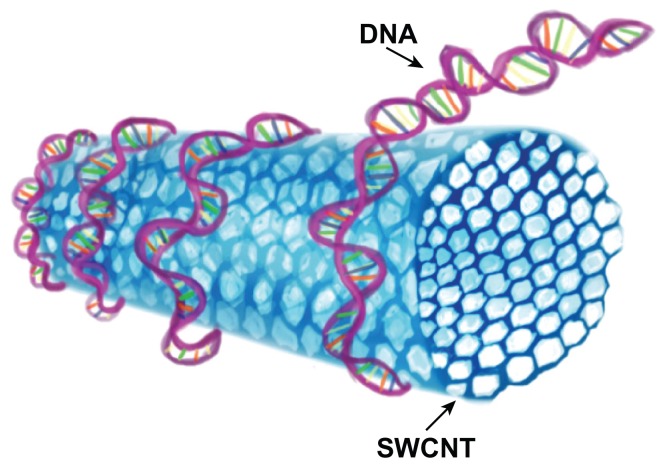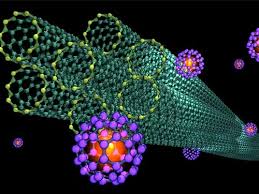Structure of biomolecule dispersants in the DNA of SWCNTs nanotubes (PhD in nano-microelectronics)
Researcher and author: Dr. ( Afshin Rashid)
Note: Many biomolecules have the potential to differentiate between DNA of a particular type of nanotube. Selective diameter-dependent scattering of SWCNTs is achieved by using Chitosan polymer and polyethylene glycol oligomeric polymer (PEG) through torsion adsorption.
The spiral complexity (mono-no-Falotine Falvin) on nanotubes is very interesting. This material can selectively separate 85% of nanotubes (6,8) from a nanotube sample with a wide diameter distribution. DNA has been widely used to separate specific types of nanotubes by non-covalent twisting . Using single-stranded DNA, nanotubes can be dispersed in solution , and how DNA is twisted selectively depends on the specific sequence of the DNA strand. You through the layers of oligo nucleotide (GT (Poly orderly structure SWCNTs very high on the turns and cause separation of nanotubes, metal / semiconductor -based electrical properties of the nanotube diameter is. After the interaction between the DNA and nanotubes it'll be done. The DNA separation method is used to disperse the nanotubes. During which nanotubes (5,6) were enriched from nanotubes (3,10) . Enrichment of metal nanotubes increases as the length of DNA decreases. A method of isolating , purifying nanotubes One by twisting DNA with chromatography depends on the size of the sequence of DNA, of certain of the nanotubes from the mixture separates and does this by chromatography were integrated as the semiconductor main Unique chirality is separated from a high-purity synthetic nanotube mixture . That the structural order of the SWCNT-DNA hybrid causes structure recognition SWCNTs can reveal theoretical approximations that the purine-pyrimidine pattern has been identified as a sequence pattern that can form a hydrogen bond to form a two-dimensional plate and, as a regular three-dimensional tube , can selectively form on nanoparticles. Wrap the pipes. Isolated (5,10) nanotubes (TTT3) have been sequenced using DNA with T sequence , which is very efficient for use in FET equipment.
Octadecylamine selectively interacts with semiconductor SWCNTs , provided the SWCNTs are oxidized. On the contrary, the use of propyl amines Vayzv propyl amines in THF, selective adsorption on metallic SWNTs do it. This causes the solution to condense from the metal nanotubes. Different colors of nanotube suspensions are observed, indicating the high purity of specific types of SWCNTs. Amines can also be attached to SWCNTs via covalent bonding , but in this case there is no selectivity for metal or semiconductor SWCNTs .
Conclusion :
We conclude that different surfactants have been used to classify SWCNTs based on chirality . Selective separation of SWCNTs is performed using added salt SDS solution . The diameter- dependent and chiral bonding applies to general surfactants (sodium diclofenac sulfate 10), (sodium dicyl benzene 11) sulfonate, and (sodium covalent 12) in aqueous solution.
Researcher and author: Dr. ( Afshin Rashid)
PhD in Nano-Microelectronics




